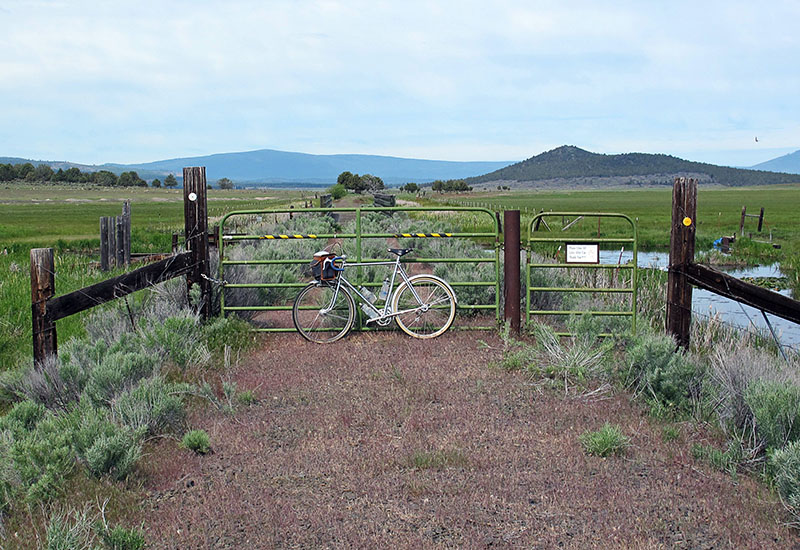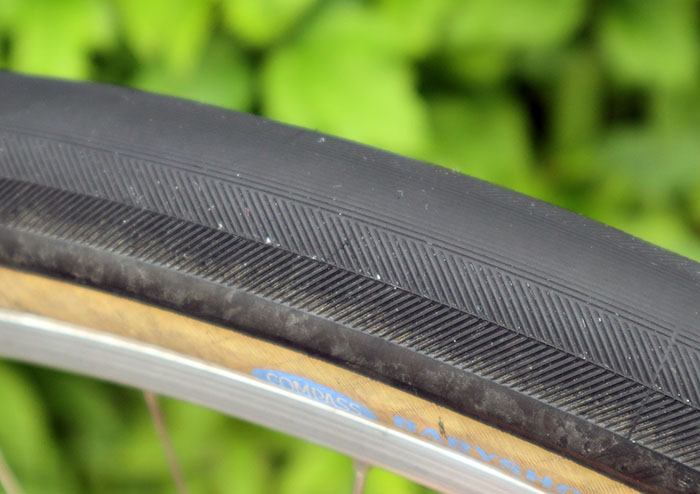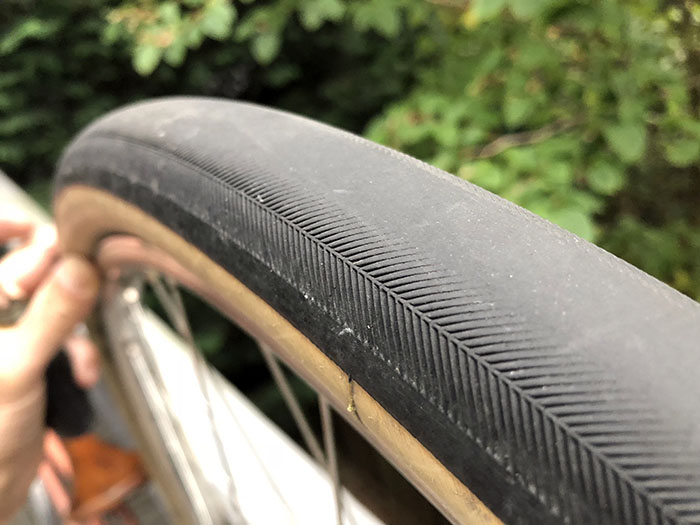How Long Do Compass Tires Last?

One of the less-noticed results of the ‘Wide Tire Revolution’: Our tires last a lot longer these days. When I rode 20 mm-wide tires, I rarely got more than 1300 km (800 miles) out of a set of performance tires. For long-distance races, I put on new tires for every event.
Now it’s rare that my tires need replacing. Even for challenging events like the 360-mile Oregon Outback (above), I only put on a new tire (on the rear, above) because the old one had seen a lot of hard use. There are three reasons for this huge difference:
- Wider tires spread the wear over a much-larger area, so they wear much slower.
- Modern rubber compounds wear much better. In the past, we had to choose between grip or wear resistance. Today, the best tires combine both.
- Compass tires have a little extra rubber right in the center of the tread to increase the wear resistance. This adds only a few grams and doesn’t measurably change the rolling resistance, but it doubles the tire’s tread life. The shoulders of the tire don’t wear, so we keep them thin and supple.

How do you know when it’s time to replace your tires? We’ve designed our Compass tires so the center tread (longitudinal ribs) serves as a wear indicator. (The chevron tread on the shoulders gives you extra grip in corners.)
On the tire above, you can see how the longitudinal ribs are starting to show some wear. This tire has been ridden, but it still has many miles (or kilometers) left to go.

This tire is ready for replacement. The center tread is completely worn off. When the rubber gets much thinner, the risk of flats increases. And if you wear all the way through the tread, your tire can suddenly blow out. That’s a risk not worth taking to get a few more miles out of a worn tire.
The tread also allows you to check whether you have been running a good tire pressure: All the longitudinal lines should disappear – as on the tire above. If you get wear only in the very center, your pressure is too high. The footprint of your tire is smaller than ideal, and you get more wear, less traction and less comfort. (And no additional speed.)
If the wear goes far into the chevron tread on the shoulders of the tire, your pressure is too low. You’re stressing the casing more than is ideal (in extreme cases, you’ll see individual broken threads in the sidewall), your tire can collapse under hard cornering, and you may even give up a little bit in speed.

How long does a Compass tire last? This depends on several factors:
- Tire width: Wider tires spread the wear over more rubber, so they last longer. The 38 mm Barlow Pass (above) has 11 ribs in the center; the 55 mm Antelope Hill (below) has 23. With twice as much rubber touching the road, the Antelope Hill will last roughly twice as long.
- Weight: Tire wear is directly proportional to the weight of rider/bike/luggage.
- Power: High power outputs increase the wear on the rear tire.
- Both power and weight are the reason why the rear tire wears faster than the front one. If your rear tire wears significantly faster, you can rotate your tires from front to rear roughly half-way through their lifespan to even out the tire wear. I sometimes do that on bikes I use for hill intervals.
- There is no difference in the tread between the Standard and Extralight versions, so both last equally long. (The Extralight’s casing is more supple, which further improves the tire’s performance and comfort.)

Other tips for increasing the lifespan of your tires:
- UV light makes rubber deteriorate and crack. High-end tires contain more natural rubber, which is especially susceptible to UV damage. If possible, don’t store your bike in direct sunlight.
- Ozone damages rubber. Electric motors emit ozone, so don’t keep your bike near refrigerators, freezers, heater furnaces, etc.
- The shelf life of tires is very long, if they are stored in the dark with moderate humidity. I recently found an old set of tires that was ten years old, and they were as good as new.
- In the past, there was much talk about aging tires to increase their puncture resistance. It’s true that rubber should cure for optimum performance, but at least with our Compass tires, that takes only about a month. By the time Compass tires arrive from Japan in our Seattle warehouse, they are fully cured.
What does all this mean in practical terms? I expect about 5000-6500 km (3000-4000 miles) out of a 650B x 42 mm Babyshoe Pass. For high-performance tires, that is quite remarkable, and it’s dramatically lowered the cost-per-mile of high-end tires. There is no longer a need to reserve them for special events – I enjoy them even on my Urban Bike.
Click here for more information about Compass tires.


